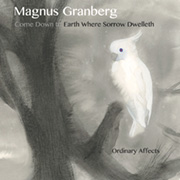 If you’re reading this, you’re probably the sort of music nerd who listens to composers like Magnus Granberg and wonder how their compositions might sound in different configurations. It’s partly intellectual and creative curiosity, but there’s also that frustration that much of the great music we hear is so often left open to interpretation and yet never heard again beyond the original version. Granberg’s music is a good example, as his string of recordings and performances present extended pieces that are heavily dependent on the colouration of their instrumental palette and a sustained, consistent mood. For the wider audience, each piece is strongly identified with the ensemble which plays it.
If you’re reading this, you’re probably the sort of music nerd who listens to composers like Magnus Granberg and wonder how their compositions might sound in different configurations. It’s partly intellectual and creative curiosity, but there’s also that frustration that much of the great music we hear is so often left open to interpretation and yet never heard again beyond the original version. Granberg’s music is a good example, as his string of recordings and performances present extended pieces that are heavily dependent on the colouration of their instrumental palette and a sustained, consistent mood. For the wider audience, each piece is strongly identified with the ensemble which plays it.
 Well, now we get to choose – or, more likely, get both and get judgemental. Meenna has released two recordings of Granberg’s Come Down To Earth Where Sorrow Dwelleth a few months apart. The first version was recorded on its premiere tour in April last year by Ordinary Affects; for the second version Granberg joins a Japanese trio in Tokyo the following November. I listened to the second version first, because it’s twenty minutes shorter than the earlier version and I had to be somewhere else in an hour. Granberg’s prepared piano threads its way through the sustained instrumental texture here as it has on other occasions, but he has revised his piece to suit an entirely new ensemble, setting traditional Japanese instruments (Ko Ishikawa’s sho and Miki Maruta’s koto) against Toshimaru Nakamura’s feedback electronics. Nakamura also appeared on Let Pass My Weary Guiltless Ghost earlier this year; electronics have often figured in Granberg’s music but on that occasion I noted that it sounded “more abrasive and confrontatial” than before. Here, with a much thinner, sparser texture, the feedback becomes a more distinct, even intrusive presence. At rare moments, a sudden percussive burst of noise punctures the surface. There are extended periods where it settles into a high tinnitus whine. The electronic tones reflect off the sho, while the koto and muted piano pair off with short, stifled sounds. It’s the strangest, starkest work I’ve hear by Granberg yet, almost reduced at times to complete stillness. Speaking as an increasingly old and grumpy man, the high-pitched stuff started to irritate at times.
Well, now we get to choose – or, more likely, get both and get judgemental. Meenna has released two recordings of Granberg’s Come Down To Earth Where Sorrow Dwelleth a few months apart. The first version was recorded on its premiere tour in April last year by Ordinary Affects; for the second version Granberg joins a Japanese trio in Tokyo the following November. I listened to the second version first, because it’s twenty minutes shorter than the earlier version and I had to be somewhere else in an hour. Granberg’s prepared piano threads its way through the sustained instrumental texture here as it has on other occasions, but he has revised his piece to suit an entirely new ensemble, setting traditional Japanese instruments (Ko Ishikawa’s sho and Miki Maruta’s koto) against Toshimaru Nakamura’s feedback electronics. Nakamura also appeared on Let Pass My Weary Guiltless Ghost earlier this year; electronics have often figured in Granberg’s music but on that occasion I noted that it sounded “more abrasive and confrontatial” than before. Here, with a much thinner, sparser texture, the feedback becomes a more distinct, even intrusive presence. At rare moments, a sudden percussive burst of noise punctures the surface. There are extended periods where it settles into a high tinnitus whine. The electronic tones reflect off the sho, while the koto and muted piano pair off with short, stifled sounds. It’s the strangest, starkest work I’ve hear by Granberg yet, almost reduced at times to complete stillness. Speaking as an increasingly old and grumpy man, the high-pitched stuff started to irritate at times.
I attributed this to the instrumentation, but this theory was quickly disproved when I heard the original version of the piece played by Ordinary Affects. These are the guys I heard in Michael Pisaro’s Helligkeit, die Tiefe hatte, nicht keine Fläche a while back. This time, the ensemble is a quartet (Morgan Evans-Weiler, violin; Laura Cetilia, cello; Luke Martin, electric guitar; J.P.A. Falzone, vibraphone) plus Granberg’s piano. Even with the extra musician and the fuller timbre of the instruments, it’s a stark, strange piece. This time the vibraphone provides the backdrop as often as not, with a faint, tremulous hum. The strings work supposedly as foreground, but play with frail, reticent bowing gestures. The piano is as likely to provide an interjection as much as the electric guitar. Any obvious figuration comes from a confluence of these small sounds and, at certain moments, work in consort to produce passages of fraught continuity and stability. At other times, sustained sounds all disappear and the momentum falls away, leave holes of silence to open up in the musical texture. The certainties from the older Granberg works are fading out; in its own sinister way it’s the most changeable of his compositions I’ve heard yet and, with that small shift in equilibrium, opens up a wealth of disturbing connotations kept dormant in his previous music.
